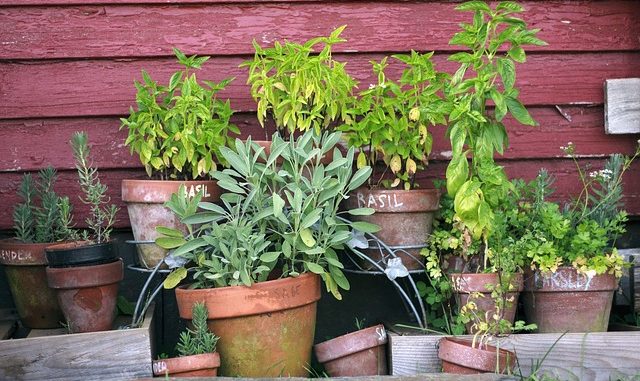
Nothing quite beats cooking with home-grown herbs.
A collection of aromatic, fresh herbs is a great asset for your kitchen. Having a plentiful supply to hand, when they are in season and at their very best, is guaranteed to add vibrant flavours and texture to your meals and elevate your home cooking to a whole new level.
The good news about herbs is that they’re pretty easy to grow; you don’t even need a garden! Most people have a south facing windowsill with room for a few pots, and with the right care and attention, your herbs will flourish.
The downside is that many tender pot-grown herbs don’t survive the winter. However, they can be harvested in autumn and stored for use throughout the winter season.
In this article we recommend our top 10 herbs for all home cooks to grow, explain how to grow and take care of them, and how to preserve them. Here are all the tips and tricks you need to get your herb garden started!

Growing Herbs
Tender annual herbs, also called soft herbs (e.g. basil, chives, parsley, coriander) will have the greatest impact on your cooking when they’re home-grown and used fresh. They need care and attention when they are growing, and will need to be brought inside in the winter. This means they are often better grown in pots.
Hardy perennial herbs, also called woody herbs (e.g. thyme, rosemary, sage) are essential staples for any serious cook. They can be grown successfully directly in the garden or in pots. They will benefit from a hot, dry location, but these herbs are pretty resilient and will generally survive winter well.
The Golden Rules:
- All herbs can be grown in a reasonably fertile, well-drained, gritty soil. If drainage is a problem, plant your herbs in pots.
- Most herbs prefer a neutral to alkaline soil.
- Planting in a hot, sunny location is particularly important for obtaining good herb flavour.
- Your herbs will not need much fertiliser. Over feeding can in fact decrease the concentration of flavours.
- Choose containers which give herbs a deep root run. ‘Long tom’ pots have the required depth and look really good when grouped together. Terracotta pots look great and are porous so less likely to get waterlogged. They do dry out very quickly in summer though, so always keep an eye on them and water regularly.
- Keep your herbs well trimmed to stop them from bolting.
- Last but not least, give them the space to breathe and grow out – if you overcrowd your herbs, they will quickly die.
Sow your seeds any time from late January to early May. If you want quicker results plant pre-potted herbs from garden centres. Avoid those you get in supermarkets, they will have been forced and as a result will be stressed. They are unlikely to give you robust healthy plants.
Just remember: keep them watered, make sure they are able to drain, give each plant enough space to breathe and trim them regularly.
Our Top Ten Garden Herbs:
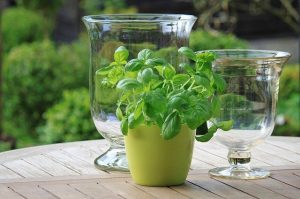
1. BASIL – Ocimium basilicum
This soft herb is a key ingredient in many recipes, especially summer salads, Italian and Thai cooking.
It is best added to dishes at the end of the cooking process, or simply folded through salads, so you don’t ruin their structure and subtle flavours.
It is the most widely sold herb in the UK. Originally from India, it thrives in British soil, smells wonderful and is perfect for your kitchen garden.
- Sow seed from January to early April.
- Grow in rich, light well-drained to dry soils in full sun.
- Greenhouses are ideal, as are windowsills.
- Pinch out growing tips to encourage bushiness and delay flowering. though regular sowings are still needed to a summer-long supply
- Leaves are picked during the growing season and used fresh or dried
- With so many varieties of basil available to grow, why not experiment with a few this summer and enjoy the different tastes on your home-made salads and pasta dishes.
- Basil is very tender, so must be moved inside during the winter months.
- Buy seeds here
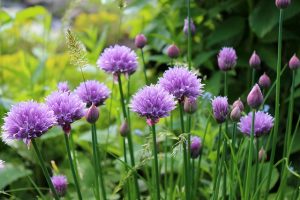
2. CHIVES – Allium schoenoprasum
Chives are hardy perennials. They are very easy to grow and will survive outside all year round.
They are a great addition to a kitchen garden and are also widely used in cottage style gardens; their pretty, purple blossoms make them very popular as boarder plants.
The entire chive plant is edible, so they are very versatile. The flowers can be picked and used as garnishes, and the leaves can also be eaten. With their light onion flavour, chives can be used in all sorts of summer dishes, from a garnish for new potatoes, to soups, salads and omelettes.
Growing chives…
- Sow seed from January to early April.
- Plant them in rich, well-drained soil either in the ground or in a pot, and place them in a sunny spot.
- Cut down to the ground after flowering to produce fresh leaves through the growing season.
- Buy seeds here

3. CORIANDER – Corinadrum sativum
Also known as cilantro and Chinese parsley, coriander is a tender annual.
- Sow coriander seed every few weeks for a continuous supply of fresh leaves throughout summer
- Prefers well-drained fertile soil in full sun, although leaves may be more productive in part shade
- Buy seeds here
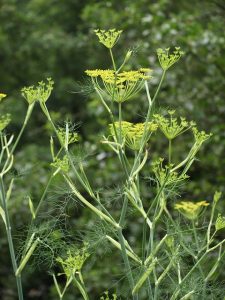
4. FENNEL – Foeniculum vulgare
The herb fennel is closely related to the vegetable Florence fennel.
The herb form is a hardy perennial. Once established, it is a long-lived plant that is covered in pretty yellow flowers in early summer.
Although indigenous to the Mediterranean, it can be grown easily from seeds in the UK, and is a brilliant addition to your garden.
Every part of the plant has a mild, aniseed flavour. The flavour of the seeds is more potent due to their powerful essential oils.
Its young tender feathery leaves can be used for garnishes, in a salads, soups and with fish. The seeds are a wonderful ingredient for both sweet and savoury dishes.
Growing Fennel…
- Fennel is pretty indestructible and will grow well in any garden soil, providing it is placed in free-draining soil in a sunny spot.
- Sow in early spring.
- Fennel hates having its roots disturbed so sow either into pots or the ground where it is to grow.
- Remove dead stems at the end of the growing season.
- Buy seeds here
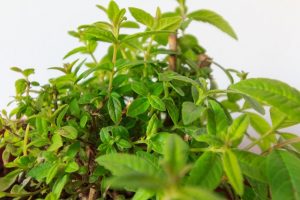
5. LEMON VERBENA – Aloysia citrodora
Lemon verbena is a perennial herb, but it does not like cold British winters, so is best grown in a pot so you can move it inside.
A deliciously fragrant herb, the aroma will remind you of pure undiluted sherbet lemons.
It will form a shrubby plant that benefits from regular pruning to keep it from getting leggy.
Regular trimming will give you plenty of citrusy leaves to use. Snip off shoots for summer cocktails, try steeping leaves in hot water to make a wonderful calming herbal tea.. You can also chop the leaves and use them to flavour fish and vegetable dishes.
Growing lemon verbena…
- Prefers well-drained fertile soil in full sun.
- Keep in a greenhouse during the winter months.
- Trim regularly to maintain shape and vigour.
- Buy seeds here

6. MINT – Mentha spicata
Common mint, also known as spearmint, is a hardy perennial herb that is very easy to grow.
With its refreshing and strongly aromatic leaves, the herb is often used to flavour salads and sauces. It is an essential ingredient for a middle Eastern cuisine. Its leaves can also be dried or used fresh to create a soothing herbal tea and it is an essential garnish for many summer cocktails.
There are many different varieties of mint to choose from with leaves that smell completely different. Not all are good for culinary use, so choose what you grow carefully.
Growing mint…
- It needs moist, fertile soil in sun or part shade.
- It grows vigorously and can be invasive, so it is best grown in a container, or a bottomless bucket set into the soil making sure the lip of the container remains above the surface to prevent shoots from escaping over the top.
- Give plants plenty of water, especially during hot, dry weather.
- When plants have finished flowering in summer, cut flowered shoots back to 5cm above the surface of the compost.
- Avoid growing different varieties of mint close together, whether in pots or the ground, as they can lose their individual scent and flavour.
- Buy seeds here
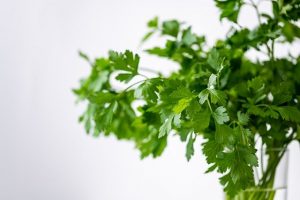
7. PARSLEY – Petroselinum crispum
Parsley is a hardy biennial herb. Unlike most herbs, it grows best in partial shade; in full sun it is likely to bolt.
One of the most popular herbs in British cooking, parsley is an absolute must to grow in your garden.
Parsley has many culinary uses. It is used widely in French, Italian and Middle Eastern cuisine, combines well with basil to make pesto, and used in soups and stews.
Growing parsley…
- Sow seed from January to early April.
- Prefers fertile, well-drained neutral to alkaline soil in part shade
- It will require plenty of water in dry weather.
- Buy seeds here
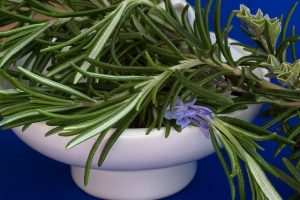
8. ROSEMARY – Rosmarinus officinalis
An evergreen shrub, its needle-like leaves have an unmistakable aroma and are available fresh all year round.
Originally from the Mediterranean, rosemary is widely used in French, Spanish and Italian cooking. It is widely used to flavour soups, sauces and stews and is paired with roast meats such as lamb and chicken.
It is a particularly nutritious herb and has a number of associated health benefits.
Growing Rosemary…
- Well-drained, neutral to alkaline soil in a sunny spot.
- Remove dead stems and weak growth in spring, prune after flowering to encourage bushy growth
- Cuttings can be taken from late summer to early autumn.
- Buy seeds here
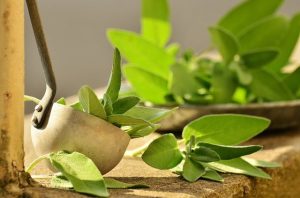
9. SAGE – Salvia officinalis
A low-growing evergreen shrub, the leaves are available to pick all year round.
The intense flavour of sage, with its slightly peppery taste, makes it one of the most widely used culinary herbs in the UK. Unusually, the flavour increases as leaves grow, so larger leaves can be used as well as the small tender leaves.
A good source of vitamin C and potassium, it also has a number of associated health benefits.
There are a number of different varieties; green, variegated and purple forms, which make it a very attractive addition to a herb garden.
Growing sage…
- Thrives in well drained sunny areas.
- Sage dislikes damp conditions and low light in winter
- Hard prune in early spring to promote bushy growth
- Cuttings can be taken from late summer to early autumn.
- Buy seeds here
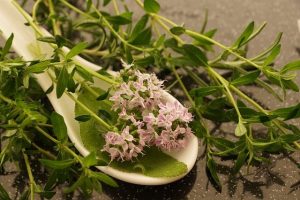
10. THYME – Thymus vulgaris
The aromatic foliage of thyme will fill the air with perfume on a warm sunny day.
Its attractive flowers are also a magnet to wildlife.
Thyme work wells with Mediterranean vegetables, eggs, pork, lamb, fish and game. It is also and important ingredient in French cookery and is an essential part of bouquet garni and herbes de Provence.
Growing thyme…
- Well-drained, even stony poor soils in sun.
- Plants hate too much water, but ensure plants in pots are not allowed to dry out completely for any length of time during long hot, dry spells.
- Place a collar of horticultural grit or gravel around plants to protect the foliage from wet soil.
- Trim lightly after flowering to maintain bushy habit
- Cuttings of thyme can be taken from late summer to early autumn
- Buy seeds here
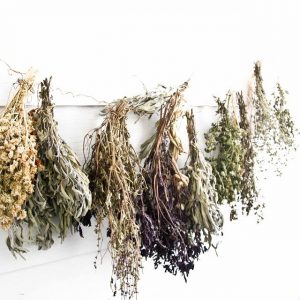
How to Dry and Store Herbs
It is important to pick leaves, flowers or seeds for drying early in the morning before the sun has had chance to evaporate essential oils.
There are a couple of effective ways to dry herbs, and because herbs don’t contain much moisture they are all pretty effective.
Air-drying is cheap and effective. Use an air-drying rack or net (available through our shop). Place this in a warm, dry place. Spread the herbs thinly and turn every 12 hours. Alternatively tie herbs in bunched and hang in a warm, dry place. It is helpful to use a tie twist to secure the stems. Check the bunches regularly and tighten the bunches as they dry out.
Dehydrators can also be used, although these can be expensive. If your oven can be set as low as 38C it will work equally well.
Once dried, herbs should be stored in airtight containers, out of direct sunlight. They should keep for up to 12 months.

Leave a Reply